July 2018 – Volume 20, Issue 5
In This Issue
Flanigan’s Eco-Logic
Quote of the Week
Floating Wind for the Pacific
EE – California-Style!
Bloomberg’s New Energy Outlook
Sponsored Riding and Ride Sharing
Sustainability and the Little Stuff
EcoMotion Updates
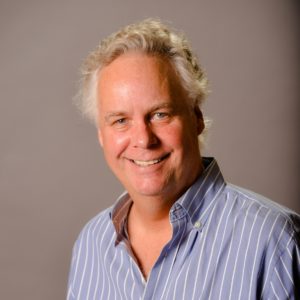
Flanigan’s Eco-Logic: Sustainability, Food, and Meatless Mondays
Sustainability is necessarily broad. By definition, to sustain life as we know it on the planet, we must take care of a broad spectrum of issues. We have to sustain our use of resources… be they energy, water, mineral. We have to sustain our air, and our land. We have to sustain our communities, our educational pathways and culture. And we have to sustain ourselves, our bodies and minds.
Food is just as important to sustainability as energy. Like water, it’s even more basic to our needs on Maslow’s hierarchy. We are what we eat. I cherish the advice of a University of Vermont Nutrition professor, Joyce Livak, whose guidance for a healthy cuisine is really simple: Eat a variety of colors. We try to eat something green every night.
Michael Pollan is a terrific journalist and author and University of California Berkeley professor. He wrote The Omnivore’s Dilemma and other great books on food choices. And when pressed hard to advise others on diets, advice he resisted to give as a journalist, he summed up his recommendation in seven words: “Eat Food, Not Too Much, Mostly Vegetables.”
So why is food so important to global sustainability? How we grow and process food has great impacts on the earth. Experts claim that “our broken food system” is causing massive deforestation, death and even extinction of species, gross air and water pollution, and contributing more greenhouse gases than the entire transportation sector.
Meatless Mondays is a movement dedicated to shifting our society ever-so-slightly to a less energy and water intensive diet. Meatless Mondays is about finding innovative ways to make meatless and vegetarian dishes part of our everyday culture and cuisine. “Skipping meat one day a week is good for you, great for your nation’s health, and better for the planet.”
The idea is not new, actually both Meatless Mondays and Wheatless Wednesdays were introduced by the U.S. Food Administration during World War 1. Then, 13 million families signed a pledge to observe these conservation days. FDR brought back the concept in World War 2, carried on by President Truman immediately after the war to help feed war-ravaged Europe.
Today’s Meatless Mondays movement was founded in 2003 by Sid Lerner, “a former ad man turned health advocate,” in association with the Johns Hopkins Bloomberg School of Public Health. Lerner’s vision was to create awareness about preventable illnesses. He was concerned that Americans were eating 75 pounds more meat each year than prior generations. Monday is a perfect day to make small, positive changes.
Now a movement is underway. Fully 43 million Americans eat meat-free dishes regularly; 80% of them do not consider themselves vegetarians or vegans. In five years, Meatless Mondays has reduced greenhouse gas emissions the equivalent of driving 1.4 billion miles. Demand for plant-based foods up 140% in the past few years, and more people identify themselves as vegan or vegetarian or “flexitarian.” Meat consumption is allso down in public schools.
In May 2009, Ghent, Belgium, became the first non-U.S. city to go meatless. Shortly thereafter, Paul McCartney introduced the United Kingdom to Meat-Free Mondays. Meatless Mondays is now active in 44 countries. Toolkits are available.
Quote of the Day
“People who behave themselves rarely make history.”
Randy Britt rolls out an adage at the Statewide Energy Efficiency Collaborative in Sacramento, encouraging the crowd to be vital in today’s dynamic energy sector
Floating Wind for the Pacific
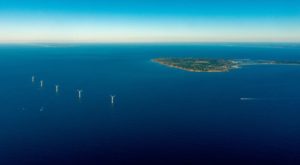
http://dwwind.com
Offshore wind is coming to America. Not if, but when and how! The 30 MW Block Island Wind Farm was energized in December 2016 and was the first offshore wind farm in the nation. Located in Rhode Island, the wind farm takes advantage of the East Coast’s Continental Shelf and its shallow waters.
It is estimated that a terrawatt of windpower could be generated off the coast of California, 13 times more capacity than what is generated by all land-based win farms across the country. The potential is huge. The National Renewable Energy Laboratory (NREL) estimated in 2016 that offshore wind in California could produce 112 GW. That’s ~225% of our State’s peak demand.
California Governor Jerry Brown, seeing the potential for offshore wind in California, formed a state task force to coordinate with the federal Bureau of Ocean Energy Management. The task force began by initiating the process of identifying suitable wind areas, looking at wind strength, water depth, proximity to power lines, impacts on fishing, other commercial uses, marine sanctuaries, Department of Defense activities, and marine life populations.
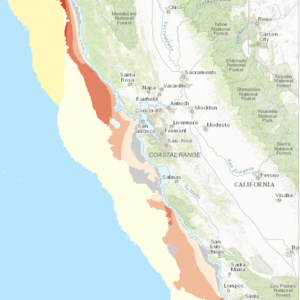
California Offshore Wind Resources: www.caoffshorewind.databasin.org/maps
The task force members know that every project will spark some criticism, from fishing, or tourism, or wildlife organizations concerned about whale and bird migrations. The U.S. Navy has said no to offshore wind development in major tracts of ocean, including all of San Diego and Los Angeles counties. It created a map of “wind exclusion” areas that will challenge developers. And wind farms may face both state and federal regulation in siting the turbines and their undersea transmission lines. States control the first three miles offshore; the federal government controls the seas from 3 – 200 miles offshore.
What else is holding back offshore wind development in California? The Golden State has a lot at stake to reach its ambitious renewable energy goals. But there is a fundamental issue of geography: The Continental Shelf off the Pacific Coast plunges steeply and quickly, making it prohibitively expensive to build normal underwater foundations for wind turbines.
Thus the concept of floating wind turbines: They can be anchored to the sea floor and be deployed in deep waters. Furthermore, floating wind allows developers to go further offshore where there are greater winds.
Floating wind is new. Only a handful of projects have been built to test the concept. These include Statoil’s Hywind turbine off the southwest coast of Norway, the WindFloat project near Portugal, and three floating wind turbines 12 miles off the shore of Fukushima, Japan. Floating wind projects in the 24 – 400 megawatt sizes have been proposed in Portugal, Scotland, France and Hawaii.
Last year, a Seattle start-up by the name of Trident Winds proposed what would be the world’s largest offshore floating wind project, off the coast of California. It would be located 33 miles northwest of Morro Bay and 21 miles from Cambria, the closest land. The farm would be made up of 60 – 100, 400-foot wind turbines spread across 63,000 acres of sea roughly a half mile deep. It would be capable of delivering as much as 1 GW of power to California’s grid, connected via an undersea transmission line buried in the ocean floor. The site was selected to plug into the transmission network at the retired Dynegy natural gas plant in Morro Bay.
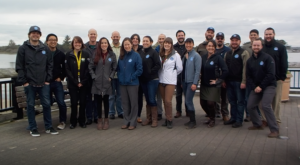
Redwood Coast Energy Authority Staff https://redwoodenergy.org/about/about-rcea/
Now a small, but highly active community power authority in Humboldt County is leading the offshore charge. The Redwood Coast Energy Authority (RCEA), a community choice aggregator, is promoting a 100 – 150 MW floating wind farm in Northern California, 12 – 15 turbines 20 miles off the coast of Eureka. The with turbines 700 – 800 feet tall. After a public solicitation process, RCEA has formed a public/private partnership with Principle Power, EPR Offshore America, Aker Solutions, H.T. Harvey and Associates, and Herrera Environmental Consultants. The goal is to tap Northern California’s world class wind resource. Average wind speeds off Humboldt County exceed 10 meters per second, or 22 miles per hour.
The United Kingdom has more turbines in the sea than any other nation. At least one turbine was installed every day last year. And, leasing the sea bed to offshore wind developers was the most profitable business for The Crown Estate last year, the company that generates income for Queen Elizabeth II.
In related news, India has announced that its capacity targets for offshore wind are 5 GW by 2022 and 30 GW by 2020. While much lower than the 60 GW onshore wind capacity target for 2022, India has 7,600 kilometers of coastline and a goal to be 21% renewably powered by 2022.
EE – California-Style!

California is now the fifth largest economy in the world, eclipsing England just this year. The world’s eyes are focused on California’s massive green movement. Utilities have made fantastic gains and are meeting their mandated Renewable Portfolio Standards. California’s utilities are on target to be 33% renewable by 2020. Next year, buildings in California will be responsible for more emissions than power plants, fully 26% of the state’s emissions.
What’s happening in the California world of efficiency? Lots. SB 350 which was authored by Senator Kevin de Leon and then signed into law in October of 2017 calls for doubling of efficiency in electricity and natural gas throughout the State by 2030. Recent regulatory rulings have stripped utilities of their energy efficiency programs, turning to the promise of more cost-effective, private-sector delivery. Soon all of the major energy efficiency programs in California – worth about a billion dollars each year – will be administered by third parties.
Here are several themes that emerged from the conference:
Natural Gas in a Decarbonized Future: Once considered the “prince of the hydrocarbons” natural gas has been in the cross-hairs of an eco-debate about decarbonizing energy use in America. On one hand, natural gas has been the “bridge fuel” to a clean energy future. It’s as good as hydrocarbons get. On the other hand, it is a hydrocarbon… and therefore very much part of the problem at hand. Try making a case for keeping gas around… even “green gas.” It wasn’t popular in Sacramento!
Methane is one of the most potent greenhouse gases. Today, concerns over fracking and discussions of leakage rates are prominent: The U.S. EPA claims a 1.5% natural gas leakage rate nationally. Some analysts say that a 2% leakage rate wipes out the benefits of natural gas over coal.
Today’s climate protection focus is on full electrification, including water and space heating which now can be accomplished using heat pumps, and even cooking… not to mention cars, buses, and trucks. We’re looking at the end of natural gas. What happened to the solar-hydrogen future?
Efficiency and Resilience: Energy efficiency still suffers from complete isolation from other forms of energy management but is less isolated. Now it is linked to resilience. The Forum featured fascinating tales of rebuilding resilient after the devastating Wine Country fires. Climate impacts are being taken seriously: Ventura County is planning a managed retreat due to sea level rise.
Linking Sustainability with Quality of Life: Times are a’changing. NIMBY (not in my back yard) has been replaced with YIMBY… yes. Bring me lots on EVs. Make everything EV-ready or EV-Accessible. Bring on ride-hailing services, and e-mobility of all kinds, including Birds. Bring on distributed solar and community solar systems; bring on energy storage at the home and community level. Far from sacrifice, we can increase efficiency and quality of life while cutting carbon. Sonoma County negotiated bulk purchase prices for electric vehicles for residents there.
Disadvantaged Communities in Focus: There’s an important and marked focus on energy efficiency services for disadvantaged communities. The disparity is profound: One million Californians do not have access to fresh drinking water. One in five Californian’s live in poverty… often in unincorporated communities with bad roads, poor water, no access to natural gas, not to mention education and health care. There’s a strong and growing advocacy for valuing the non-energy benefits that efficiency
Bloomberg’s New Energy Outlook
This past Friday, June 22, Bloomberg NEF released its annual New Energy Outlook (NEO 2018) in San Francisco. I was there to learn first-hand about Bloomberg’s research. NEO 2018 was compiled by 65 market and technical analysts in Bloomberg’s 11 global offices. The Outlook makes bold proclamations about the fuels and technologies that will dominate the energy landscape in 2050. The work was expertly presented by Seb Henbest, an Australian who lives and works in London. He clearly thrives on large and intertwined data sets!
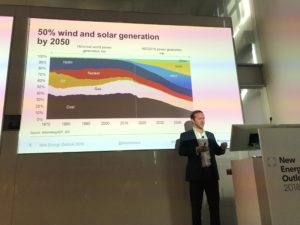
Seb Henbest presenting the New Energy Outlook
Here are some of the highlights:
Bloomberg NEF finds that cheaper renewables will fundamentally reshape the power sector by 2050. At that time, nearly half of all capacity will be solar and wind (48%), and 64% when hydro is included. Henbest was matter-of-fact: “Solar and wind have already won the race for bulk electricity. There’s no question about it.” Bloomberg NEF reports that, “Coal is the biggest loser.” Coal production and use will drop by 57%. There will be almost no coal in U.S. or Europe by 2050. Coal shrinks to 11% of global electricity generation by 2050.
NEO 2018 projects $11.5 trillion being invested globally in new power generation capacity between 2018 and 2050. Of this, $8.4 trillion will be invested in solar and wind.
Natural gas hangs in there in a limited capacity. Even with a complete coal phase-out replaced by natural gas, Bloomberg NEF analysts calculate that global temperatures will not be limited to a 2 degree C increase. Gas’s role in the energy economy will remain but change: Bloomberg’s researchers and analysts project that gas will be more about value than volume. “This is bad news for molecule sellers.”
Clearly, renewables are the action. Solar panel prices continue to fall. Recent changes in China’s domestic solar policies are anticipated to create a glut of 20 GW of solar panels on the global market. According to PV Insights, panels have reached a record low of 27.8¢ per watt. Bloomberg NEF expects the price to fall to 24¢ by year-end, a 35% drop from 37¢ at the end of 2017. Meanwhile, wind turbines are getting more efficient, pulling more energy from the wind and increasing their capacity factors. India has demonstrated how to deploy the cheapest renewables in the world. Renewables are cheaper than coal in China.
Batteries are an important new energy component; a value stack that is a perfect match for intermittent renewables. They enable solar and wind to become dominant. Batteries have undergone an 80% reduction in cost since 2010 and will continue to experience falling prices. Current worldwide production of batteries is at 131 GWh. This is projected to more than triple by 2021. NEO 2018 projects a $548 billion being invested in energy storage by 2050, with two-thirds at the grid level and one-third being installed behind-the-meter.
A summary of the report is available at https://about.bnef.com/new-energy-outlook/
Sponsored Riding and Ride Sharing
In the Netherlands, a quarter of the population bikes regularly. The government wants more. The Secretary of State of Infrastructure proposes that businesses pay their employees to commute by bike. She wants Dutch employers to pay their worker 19 Euros per kilometer to bike to and from work. Her goal is to create an additional 200,000 “B-Riders.”
Just how crazy is the plan? Not very. Employees who bike to work are in better shape and are less prone to absence through sickness. Bicycle use can enable companies to reduce the size of their parking lots. And at the same time, the government is investing in more bike lanes and bicycle parking. Research has shown that if there is ubiquitous bike access, that even when subsidies end, citizens will continue to bike for their own health, and their health of their communities.

https://www.hytch.me/
Hytch Rewards is a free app for iPhone and Androids that was launched in February of this year, and that tracks shared rides, earning distinctions and in some cases cash. The idea is to increase shared rides, be it through carpooling, ride-hailing, active transportation (walking and biking), or transit, to reduce pollution and congestion by tracking zero-emissions miles.
When two or more people connect in the Hytch Rewards app, the shared miles are validated through GPS tracking. Every time you share a ride, you earn “Trees Saved,” a “visual counter to show how much you are helping the environment.” And people who live in “sponsored areas” can also earn cash awards for each qualifying mile. Sponsored areas even have “surge rewards” during peak periods.

https://www.hytch.me/
Cash awards can be sponsored by municipalities, companies, and organizations that recognize the benefits of reduced traffic. Thanks to Nissan, individuals earn a penny a mile anywhere in Tennessee, and 5¢ a mile for the 10-county area known as Middle Tennessee. Other sponsors are layered into the system. In some areas Hytch riders can earn 12¢ a mile. And why is Hytch spelled with a Y? It’s symbolic. The letter Y represents two paths coming together.
Sustainability and the Little Stuff… Soap and Straws
Sure, we recycle bottles, cans, and newsprint. But what about the little stuff? What’s your level of repurposing and recycling? Do you have a plastic bag drying rack like my brother? Are you buying toilet paper without the inner cardboard roll? Hanging on to all those twists ties that come with bread? Do you ever re-use aluminum foil? Small pieces? Tell us.
Soaps: Treehugger reports that, “Soap is a frothy subject…. It’s a powerful, plastic-free, and cheap disease-fighting tool.” But more and more people are buying liquid soaps in plastic containers with little pumps that get thrown away. (Some 270 million plastic pump bottles go into the trash each year.) These have a higher carbon footprint than bars of soap, largely due to the packaging. Furthermore, despite bottled soap being a more expensive product, people use seven times as much liquid soap as they do bars of soap.
While many think the bottles of liquid soap are more sanitary, science has repeatedly proven that bar soap does not transmit infection. The communal bar of soap will not make you sick.
The first major study of soap and its potential spread of disease was conducted in 1965. Scientists then coated their hands with 5 billion bacteria, including disease causing strains of E Coli and Staph. The scientists washed their hands with a bar of soap, and then had a second person wash his hands with the same bar of soap. Bacteria were not transferred to the next user. The scientists concluded that the level of bacteria left on the soap, even under extreme conditions such as heavy usage and poorly designed, non-drainable soap dishes, does not constitute a health hazard.
A second study in 1988 involved inoculating bars of soap with pathogenic bacteria to see if it could be transmitted to the next soap user. But test subjects had no traces of bacteria on their hands after washing with the contaminated bars. More studies underscore soap’s great ability to fight serious infection, including Ebola.
Straws: Now what about straws? While small components of our waste stream, their consequences in the wild are oft extreme. Fully 500 million plastic straws thrown away every day in the United States, an average rate of 1.6 straws per person per day. That’s 175 billion straws a year. They litter beaches and harm animals. According to University of California Santa Barbara’s National Center for Ecological Analysis and Synthesis, 8 million metric tons of plastic trash ends up in our oceans every year. Straws are part of this. Sea turtles have been found with straws up their noses.
Originally, straws were made of stalks of grain, such as wheat or rye grass. They were really straw straws. Then came paper straws that were made using paraffin-coated manila paper. They were popular until they were replaced by plastic straws in the 1960s.
There are many solutions. First, forgo the straw altogether, or at least most of the time. The consider eco-friendly drinking straws are available in metal, bamboo, and glass. McDonalds is reintroducing paper straws in some locations. In parts of Europe it is only making plastic straws available upon request.
EcoMotion Updates
New Staff

Kellie Canning
EcoMotion is pleased to introduce Kellie Canning as Business Development Director. A California native, Kellie earned her Bachelor of Arts in Communications from the University of California at Santa Barbara, minoring in art history. She has lived in Hong Kong, Peru, and Italy working in public relations and business development. Her passions for urbane living extend from art to the environment to sustainable planning and development.
Jenny Miller
EcoMotion is pleased to welcome Jenny Miller as our 2018 Summer Intern. Jennie hails from Pennsylvania and will graduate from Penn State University in the Spring of 2019 with a degree in Environmental Studies. At EcoMotion, she is supporting solar market analyses, business development activities, and is studying how and if block chain technology will revolutionize the power sector.
Updates

Michael Ware, EcoMotion’s Senior Solar Specialist, speaking to ClimateFest participants
May 19, 2018, Santa Monica ClimateFest: Ted Flanigan presented a vision of “The Future of Energy” at the City of Santa Monica’s Climate Fest. Speaking on a panel with Ted Bardacke, Executive Director of the Clean Power Alliance of Southern California (LA’s new community choice aggregation entity), and Annette Tran, a manager of Southern California Edison’s EV program. Ted Flanigan began with a simple statement: No wires. He then proceeded with insights of the energy future and showed how Santa Monica really exemplifies a future based on smart energy management, including efficiency, solar power, storage, controls, and EV charging.
For a copy of the essay drafted by Ted Flanigan envisioning the future, please click here: The Future of Energy
EcoMotion’s Senior Solar Specialist, Michael Ware, also presented at Climate Fest, focusing a one-hour technical presentation on the solar opportunities and economics of multi-family apartment complexes. EcoMotion has managed the Solar Santa Monica program for 11 years.
June 20, 2018, Accelerated Energy Investment Forum: Ted Flanigan was one of five featured speakers – including Kevin de Leon — at the Accelerated Energy Investment Forum at the University of California Irvine’s Cove. Ted presented EcoMotion’s work with fully financed, carbon-free microgrids, discussing issues of importance to investors in the clean energy space. The microgrids developed by EcoMotion for the Santa Rita Union School District were ultimately financed by Generate Capital, a New York and San Francisco based firm run by Jigar Shah that specializes in financing renewable energy projects.
June 22, 2018, Statewide Energy Efficiency Collaborative: Dr. Shelly Morr, superintendent of the Santa Rita Union School District, presented EcoMotion’s slide deck of the “SRUSD’s PERCs: Powered Emergency Response Centers.” Dr. Morr presented the value of the solar + storage microgrids from a school administrator’s perspective, emphasizing her District’s keen focus on providing the very best educational foundation for your students, not allowing power outages to deny students of any hours of instruction. Dr. Morr praised EcoMotion’s role as the consultant that stuck with the project from start to finish. Ted Flanigan was in the audience and on hand to clarify technical points – such as the financing – and to field questions from interested city officials throughout the conference.
June 11 – 12, 2018, Millbrook School Assessment: Two weeks ago, Ted and Russ Flanigan visited Millbrook School in Millbrook, New York to update “Russ’s List,” an assessment of the potential for energy efficiency on campus conducted in 2013. The 46-building update will inform the school and its board as to how much efficiency can be purchased to reduce the School’s electricity footprint. In 2014, EcoMotion was hired to guide the School in going solar… ultimately through the financing and installation of a 1.73 MW solar field on campus. The system is now just over three years old.


